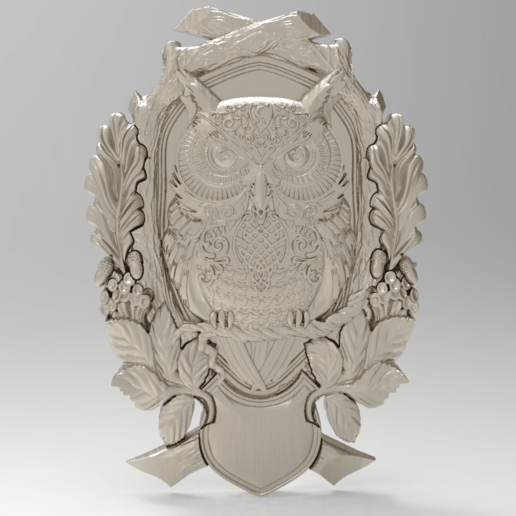
Owl shield for CNC
cults3d
Owls are birds from the order Strigiformes, which comprises approximately 200 species of mostly solitary and nocturnal birds of prey characterised by an upright posture, a broad and large head, binocular vision, binaural hearing, sharp talons, and feathers specifically adapted for silent flight. Exceptions include the diurnal northern hawk-owl and the gregarious burrowing owl. Owls primarily hunt small mammals, insects, and other birds, although some species specialise in hunting fish. They are found in all regions of the Earth except polar ice caps and remote islands. Owls are divided into two families: the true (or typical) owl family, Strigidae, and the barn-owl family, Tytonidae. Contents 1 Anatomy 1.1 Sexual dimorphism 1.2 Adaptations for hunting 1.2.1 Flight and feathers 1.2.2 Vision 1.2.3 Hearing 1.2.4 Talons 1.2.5 Beak 1.2.6 Camouflage 2 Behavior 2.1 Breeding and reproduction 3 Evolution and systematics 3.1 Theories of evolution Owls possess a range of physical characteristics that enable them to thrive in their nocturnal environments. Their broad heads, sharp talons, and silent flight capabilities make them formidable hunters. The smallest owl species is the Eurasian eagle-owl, which weighs approximately 9.3 pounds and has a wingspan of up to 21 inches. In contrast, the largest owl species is the Blakiston's fish owl, which can weigh up to 20 pounds and have a wingspan of over 28 inches. Different owl species produce unique sounds that help them find mates or announce their presence to potential competitors. Their facial discs aid in funnelling sound towards their ears, allowing them to pinpoint prey with greater accuracy. Owls exhibit varying degrees of sexual dimorphism, with females often being larger than males. The exact reason for this is unknown, but several theories propose that it may be related to selection pressures or sexual roles. One theory suggests that smaller male owls are more efficient foragers due to their agility and speed, allowing them to catch prey more effectively. Another theory proposes that larger female owls are better suited to dismembering prey and feeding their young. A third theory suggests that the size difference between male and females is a result of sexual selection, with larger females able to choose their mate and reject smaller males.
With this file you will be able to print Owl shield for CNC with your 3D printer. Click on the button and save the file on your computer to work, edit or customize your design. You can also find more 3D designs for printers on Owl shield for CNC.
